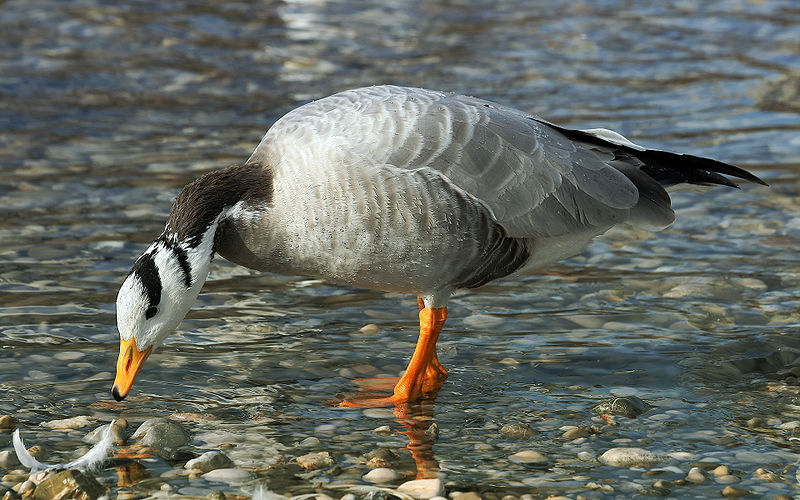
Bar-headed goose(Anser indicus)
Phylum —chordata
Class — aves
Order — anseriformes
Family — anatidae
Genus – anser
Appearance
This bird is pale grey and is easily distinguished from any of the other grey geese of the genus Anser by the black bars on its head. It is also much paler than the other geese in this genus. A mid-sized goose, it measures 71–76 cm (28–30 in) in total length and weighs 1.87–3.2 kg (4.1–7.1 lb).
Habitat
Bar-headed geese have a breeding range that stretches from Mongolia south through Russia and Western China to Tibet and as far west as Kyrgyzstan. Approximately 25% of the global population of bar-headed geese winter on the southern Tibetan-Qinghai Plateau. Another wintering area for a portion of the population is India and Bangladesh.
Behavior
This species is typical to most in the order Anseriformes in that they are a social species migrating in family groups or large colonies. They are very motile migrating twice a year over the Himalaya Mountains to and from their breeding grounds on the Tibetan-Qinghai Plateau. They migrate in "V"-formations or variations of it. They have a social hierarchy consisting of mated male-female pairs being the highest, followed by secondary females that are usually part of a harem, and lowest socially is lone females. This harem usually forms when the population is biased towards females.
Diet
Bar-headed geese generally feed on the highland grasses surrounding their lakes and streams where they nest. During other times of the year they can be found eating on agricultural crops such as corn, wheat, barley, and rice.
Reproduction
Bar-headed geese are seasonal breeders. They exhibit a monogamous mating system, where males pair with one single female for several years. During times when the population is biased towards females a polygynous system is adopted where a monogamous pair may be joined by multiple secondary females. These secondary females also breed with the male of the pair. Because they breed in large colonies, females defend their nests from socially lower females that may be using brood parasitism to increase the likely hood of their offspring's survival.
Nesting occurs from the last week of April until June. Females typically lay 3 to 8 eggs on average. After 28 to 30 days the goslings hatch. They then fledge by 55 to 60 days, and reach sexual maturity at 3 years of age.
The lifespan of geese of this breed is 30 years, but not many live to this age.
Incaptivity
Bar-headed goose feels well in captivity, does not require special care or food. It can reproduce stably, but you will need an incubator to breed your offspring. Newly hatched сhicks need a separate place from adults - a cardboard box or a wooden box. After 55-60 days, the grown goslings are returned to the rest of the herd.
At home, you can feed the bird with combined feeds sold in special stores. They are supplemented with boiled vegetables, fresh non-poisonous grass, and pitted fruit. For goslings, a mixture of crushed eggs, herbs and cottage cheese is suitable. All products must be fresh, washed, free of mold and dirt.
In summer, you can keep the bird in a closed, spacious aviary. In winter, you will need an insulated shed with a bed of straw, sawdust and pine needles. The room should be periodically ventilated, the aviary and shed should be cleaned as soon as it becomes dirty and regularly disinfected.
 Russian
Russian
 English
English
























